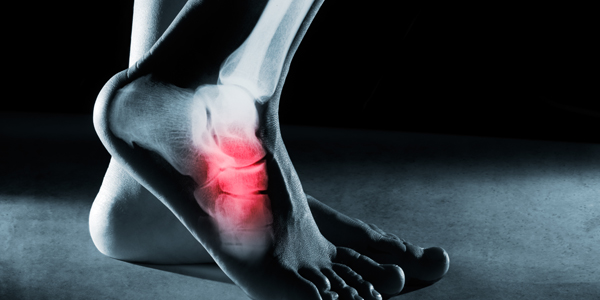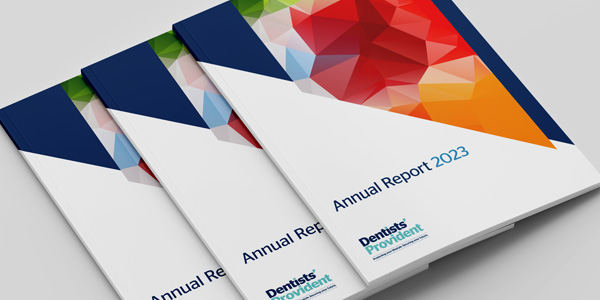
When we think about the effects of injuries on dental professionals, we tend to think about backs, necks, wrists and shoulders, and the impact they have on your practising life. There are hundreds of articles and papers that focus on musculoskeletal issues, giving postural advice and recommending exercises for your upper limbs and back. However, injuries to your feet and ankles can also affect your ability to work.
The issues in practice
Foot, ankle and knee injuries tend to be experienced through sporting endeavours; a sprain whilst running, a bad landing on the ski slopes or a fall off your bike. However, many can also be sustained during day-to-day activities such as tripping up at home or falling down the stairs at your practice.
Last year a member of Dentists’ Provident, in their early 40s fell down the stairs at work and suffered a triple fracture to their foot keeping them off work for a month, while a dentist in their 20s fractured their ankle while skiing and was off work for nearly two months.4
Stephen Price MD at Takara Belmont said, “I am not aware of any dental delivery systems in the UK that don’t have foot pedals and although the foot pedals tend to be ergonomic, light and positioned in an easy to reach place, they still require a certain amount of pressure and flexibility that couldn’t be achieved with a broken or sprained ankle or foot.”
The facts
The ankle is one of the most common areas to sprain.1 It has been estimated that there are around 50,000 ankle sprains every day in the UK with 25% of sufferers not being able to go to school, college or work for over a week. In addition, around 10% of all fractures occur in the bones of the foot.2
The Health and Safety Executive’s (HSE) statistics showed that in 2014/15 falls, slips and trips, accounted for more than a third (36%) of employee’s injuries,3 with around 97,000 people a year suffering from a Work Related Lower Limb Disorder (WRLLD). This level has remained fairly consistent since 2001. These injuries are significant because they can cause a level of immobility and that can cause a lack of independence. Although they don’t tend to be life threatening, they can reduce our quality of life.5
Symptoms
WRLLDs involve the muscles, tendons or nerves, ligaments and other tissues, and their symptoms tend to be inflammation, pain, discomfort or tingling. They are categorised in occupational health reports as either acute or overuse injuries; acute being such injuries as meniscal tears of the knee or ankle and metacarpal fractures of the ankle and foot and overuse injuries including shin splints, ankle sprains, achilles tendonitis and plantar fasciitis in your foot.5
Accidents
In 2015 we paid over half a million pounds in claims for accidents that kept dentists off work, including recreational and sporting injuries, with more than £200,000 claimed for fractures alone.6
A Dentists’ Provident member in their late 20s was rock climbing last year and fractured their foot and ruptured their knee ligaments. We paid them over £3,000 while they were off work for five weeks as their leg was in a plaster.4
Badminton is a sport you probably wouldn’t consider as dangerous as rock climbing, but last year one dentist in their late 20s was playing when they fell over and fractured their ankle. They had to take time off work as their ankle was in plaster.4
However, it isn’t just the more obvious fractures that can keep you off work. Bryan Gross head of claims and underwriting at Dentists’ Provident said, “We get a number of members claim for sporting accidents and although the minor bumps, sprains or strains may only have you off work for one or two days, you could find yourself in the position where your doctor recommends you immobilise your leg or ankle for a short period to begin the healing process and to avoid further injury. You may find this hard to do in practice and by not following their advice you could potentially end up extending your recovery time.”
Treatment
Fractures and dislocations are easy to diagnose when you can clearly see a bone sticking out of your ankle, hear a crack or see it in an odd position. However, it’s sometimes hard to tell if its either strained or broken if there is only general pain and tenderness, bruising and swelling or the inability to put pressure on it. It’s best to get it checked out straight away to be able to follow the most appropriate treatment plan and achieve the quickest recovery.7
In 2003, one study in the West Midlands looked at how patients were treated for ankle sprains when they went into their local accident and emergency units. Although they found that there was a significant variation in the treatments available, most injuries only needed to be treated with a support bandage.8
If it isn’t a break, then rest, ice, compress and elevate (RICE) or PRICE with protection being considered first, are the usual recommendations for strains and sprains, but you may also need to follow a rehabilitation programme with a physiotherapist.9 Some studies however, have indicated that there isn’t enough scientific evidence that RICE is effective for acute ankle sprains, and scientists suggest that your treatment should be tailored specifically for you using expert opinion as well as national guidelines.10
Some studies have also shown that being more lightly active such as walking in the first week of an ankle sprain injury, can help it to heal quicker and actually can improve its short term function.11
Other implications
Something you may not be aware of is that people with diabetes are at a much greater risk of experiencing problems with their feet because having higher levels of blood sugars can damage circulation. Where these symptoms are left untreated, it could result in foot ulcers and infections that could, in extreme cases, lead to amputation. However, most foot problems are preventable with good foot care. Diabetes UK recommends that you get an annual check by a specialist.12
Prevention
Obviously we can all try and be more careful when we are being active, playing sport or even when we are just going about our daily routine, but it’s often hard to notice every potential pitfall when you are rushing around or running up and down stairs, and you could find yourself a victim of an unexpected accident.
However, you can ensure you have safety measures in place at your practice, are suitably experienced in your sport or leisure activity and using the correct equipment, plus ensure your first aid training is up-to-date.
Richard Lopez, senior physiotherapist for Nuffield Health at Wessex Hospital, says, “Physiotherapists are experts in bio-mechanics. They have specialist knowledge of how the muscles, joints and ligaments in the body interact to produce movement. Even if you do not have any pain or symptoms after an injury a physiotherapist can review your flexibility, strength and core stability to identify any weaknesses that could cause a problem. They will then advise you as to the best intervention."13
Elizabeth Smith, registered podiatrist in Surrey says, "When doing any sport it is really important to choose the correct footwear. This enables you to be comfortable and cause minimum damage to your feet. Your trainers need to fit well to avoid damage to soft tissues and to help support the ankle. Poor fitting trainers can cause blackened nails and bruising of the nail bed. The apex of the toes could also be damaged if the trainers are not fitted correctly."14
So it’s clear, it is important to remember to look after your feet and ankles, as much as your back and wrists, as any injuries could have a significant impact on your life and work.
References available on request.
This article is intended for information only. It is not designed to give financial or medical advice, nor is it intended to make any recommendations of the suitability of our plans for a particular individual. Full details of our contract can be found in our rules on our website www.dentistsprovident.co.uk. Dentists’ Provident Society Limited does not accept liability and responsibility for changes made to this information. Some of the information in this article has been obtained from third parties. While we believe the information to be reliable; we make no representations as to its accuracy and accept no responsibility or liability for any error, omission or inaccuracy in the data supplied by any third party.
If you have any questions, please contact our member services consultants by emailing press@dentistsprovident.co.uk or calling 020 7400 5710.
If you have any questions, please contact our member services consultants by emailing
memberservices@dentistsprovident.co.uk or calling 020 7400 5710.

Our 2024 Annual General Meeting will be held at 91-94 Saffron Hill, London, EC1N 8QP on Friday 24th Ma…
Read more
The 2023 annual report from Dentists’ Provident, a leading income protection provider for dental profe…
Read more
Our next exhibition is the British Dental Conference & Dentistry Show in May, where we look forward to meeting anyone interested in becoming a member or members wanting to discuss their plans.